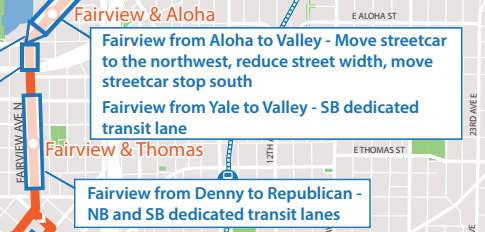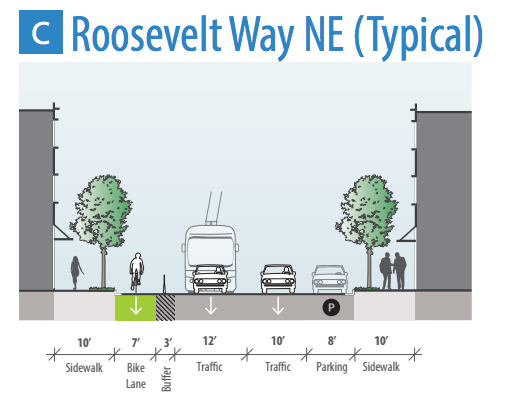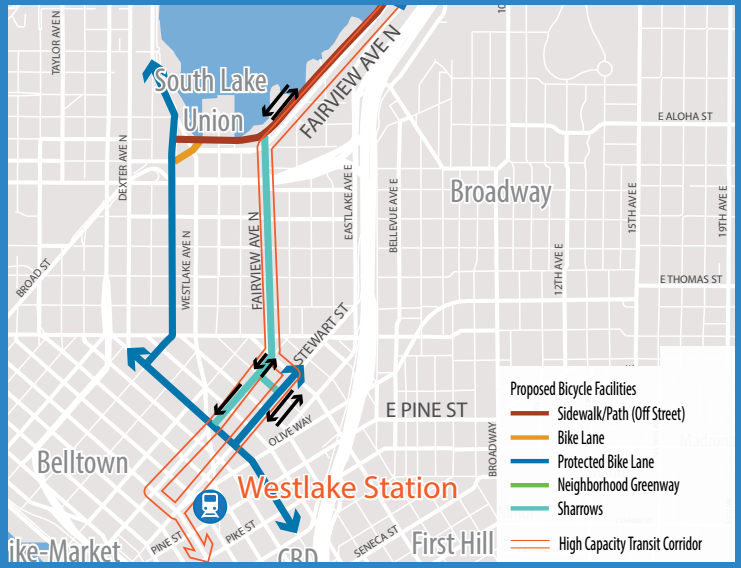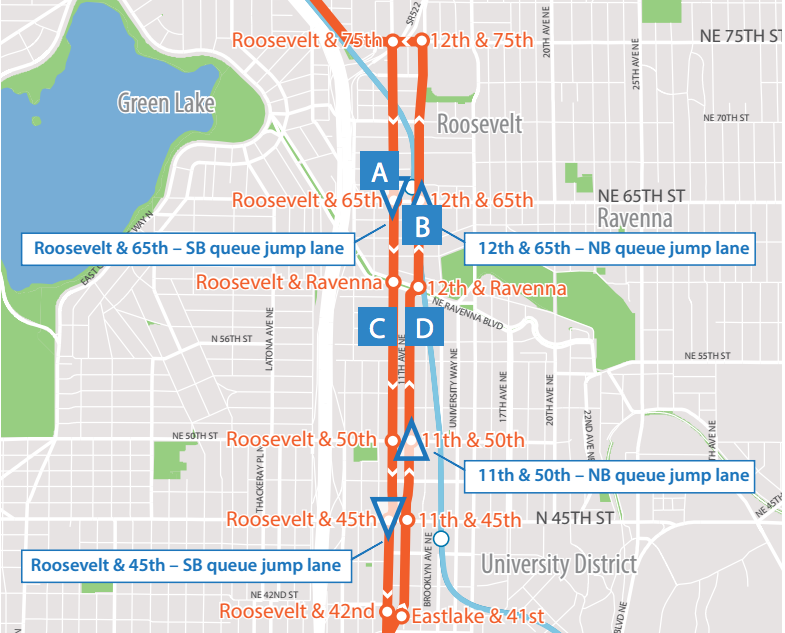Almost all transit advocates are in agreement that the proposal that the Seattle Department of Transportation (SDOT) unveiled in late June for improvements to turn the Eastlake and Roosevelt corridor into a high capacity transit corridor leaves much to be desired.
SDOT was tasked with analyzing the level of investment that would yield the best level of service relative to cost. The agency settled upon three “levels” of improvements that could be made to bus service here: current RapidRide service (this would only be speed improvements that come from off-board payment and all-door boarding), RapidRide+ targeted improvements, and full on Bus Rapid Transit.
| Average transit speed | Cost magnitude | |
|---|---|---|
| Existing | 6.5 mph | |
| RapidRide | 7.7 mph | $ |
| RapidRide+ | 8.3 mph | $$ |
| Full BRT | 21.5 mph | $$$$$ |
After studying the alternatives, SDOT has released what is called the “locally preferred alternative”—they have essentially ruled full BRT to be off the table, focusing instead on “targeted” improvements. Unfortunately their aim is not that great. Along most of the corridor, the trolley buses would be running in mixed traffic with the exception of some business access & transit (BAT) lanes and transit-only lanes. The completely exclusive lanes are almost entirely based around queue jumps at intersections and therefore take up a very small percentage of the right of way in the corridor.
After the jump are some ideas for fixes that might improve the project as a whole:
- Transit lanes on Fairview south of Mercer must be complete. Stopping a northbound transit lane on Fairview Avenue at Republican Street severely limits its effectiveness. SDOT argues congestion is too severe to allow transit lanes at that intersection. This is counterintuitive thinking—this chokepoint has a possibility of rendering the entire line less effective.

- SDOT should reconsider the amount of parking retained. Along the entire corridor, more than half the parking spaces (850 out of 1630) were retained. This is mainly made up of spaces north of 45th Street, since only 28% of spaces were kept from downtown to U District station. SDOT should take another look at travel times with increased removal of parking spaces to provide consistent BAT lanes.

- Connect the project’s bike lanes more fully. The bike aspect of the plan is pretty robust in comparison with past projects, particularly along Eastlake and north of the canal. It might be once again the deep freeze that downtown bike planning is caught in, but it is disappointing to see the protected bike lanes on Stewart Street terminate at 7th Avenue. Bike lanes further downtown are arguably more important given the interaction with the streetcar tracks that will be happening when the Center City Connector runs on Stewart. We should plan for this now, not simply leave that out of the plans and figure it out later. A bike connection to Westlake with bike share stations mapped out is essential to make our downtown bike network complete.

P.S. Sharrows are not bike infrastructure. No points for including them on your map, SDOT. Fairview Ave N is an important corridor and you are going to need to figure out how to serve it with bikes sooner rather than later.
- Consider a contra-flow alignment on the same street north of the ship canal. This idea is the most out-there idea on my list, but SDOT should seriously consider, before laying very expensive trolley wire on two different streets in north Seattle, whether it is in its long term interest to keep Roosevelt and 11th Ave NE as one-way streets. Two-way streets are generally agreed to be better for all users, especially vulnerable ones. Having a transit route on a couplet also reduces the walkshed that is able to access both directions of the line. Adding a contra-flow bus lane to Roosevelt Way by taking away the parking lane would make a lot of sense from a transit riders perspective but may be more than the “locally preferred alternative” could stomach.
There is still time to get this project right. SDOT is currently considering whether they want to have the project completed to U District station or to Roosevelt station by the time that Northgate Link opens in 2021. Considering the project becomes more and more watered down the further north it gets, advocates might recommend stopping at 45th and showing how the project benefits residents and riders. Because this will be a RapidRide branded corridor, it is important that only near-top level service be introduced along any new RapidRide corridors. Past rollout mistakes demonstrate the public perception issue that arises when advertised improvements are not quite fully there.
SDOT is accepting comments through July 7th: submit your comments here.
Ryan Packer has been writing for The Urbanist since 2015, and currently reports full-time as Contributing Editor. Their beats are transportation, land use, public space, traffic safety, and obscure community meetings. Packer has also reported for other regional outlets including BikePortland, Seattle Met, and PubliCola. They live in the Capitol Hill neighborhood of Seattle.


